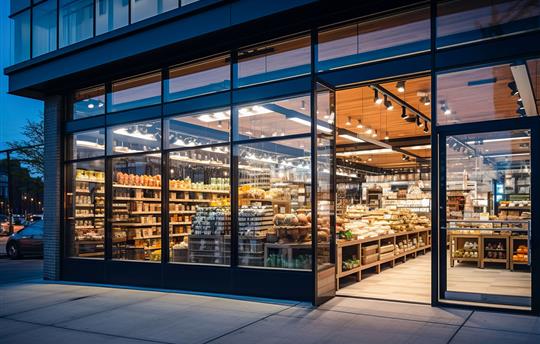The Evolution of the Retail Environment
8/1/2023 Matthew Tilley

Shopping has traditionally been a one-size-fits-all experience, but a peek into the near future indicates a different reality is on the horizon. While a store’s layout and design have largely shaped how we navigate a physical shopping environment to this point, the future promises a more personalized and exciting experience.
In this Business to Human podcast, we sat down with Hans Fischmann, the VP of Product Management for RRD, as he describes what’s coming for the store experience — and what will be required to get us there. Here, we look at the connection between retail media networks and modern stores as Fischmann explores:
-
The future of the grocery store
-
The emergence of “headless retail”
-
The big picture of privacy regulation in the U.S.
Envisioning the future of the grocery store
When we think of throwing on sweatpants and heading out for our weekly grocery shopping, “personalized” is typically not the first word that comes to mind.
Grocery stores, for the most part, have stayed the same since the 1950s. The same parallel aisles, shopping carts, and harsh overhead lights welcome every shopper that comes in through the doors to have their universal grocery-shopping experience. Even the layout of the store is intentionally planned so that every shopper traverses the aisles in a certain way.
While this approach has proven to work for decades, a personalization of the shopping experience is on its way, says Fischmann: “The experience within stores will begin to be personalized. Information will be fed to us in ways that are appropriate and contextually relevant to what we’re doing.”
These personalization strategies could be as simple as letting shoppers know when something they need is in store and precisely where it is. In addition, this information might shift throughout the day, depending upon audience, time, and other information garnered from shoppers.
The rise of ‘headless retail’
Fischmann recalls a unique shopping experience he had while in Charlotte, North Carolina, where he was introduced to the new concept of “headless retail.”
Upon arrival, he “checked in” using his credit card. There were no checkers and no workers at the registers. When he grabbed an item from the shelf, it would be added to his cart, both literally and digitally. If he changed his mind about an item, putting it back on the shelf would remove it from his total cost. He was then charged for all the items he kept as soon as he walked out of the store.
This type of store setup has endless possibilities for personalizing a customer’s shopping experience — and learning more about your specific audience, as well as how to target and cater to them.
“The store’s system might recognize that I prefer one brand of soda over another. Or it might know that I actually like to eat yogurt in the morning, and so maybe it begins presenting yogurt to me in a more interesting fashion. If I were a member of their loyalty program, maybe the prices on certain products would change dynamically as I walk throughout the store,” explains Fischmann.
With this technology, the store is able to filter the customer’s profile, catering to their particular shopping patterns. The shopper no longer has to wander around the store, sifting through thousands of products that may not be something that they need.
The big picture of privacy regulation
Although there are still a few steps that need to be taken before stores can make the jump to a “headless” retail reality, glimpses of this future are already out in the real world: sensors that can detect when items are being taken off the shelf; self-identification technology for when shoppers enter the store; and security systems that safeguard the process.
One major roadblock to this concept is privacy. Because personalization requires identifying factors from the individual, privacy concerns are guaranteed to arise. But, Fischmann suggests, identification in “headless” retail can be as private as one prefers.
“The idea is there’s a ‘blob,’ and that blob is standing in front of the bread aisle and will probably want peanut butter and jelly to go with that, right? As we see the incorporation of all these technologies come together and synthesize that information into a cohesive picture, that’s how we get to personalization in a way that doesn’t violate anyone’s privacy,” he says.
Privacy regulations and legislation are becoming more and more prevalent, and it’s likely that these will only increase in the years ahead. Put in place to protect consumers, these regulations allow them to choose what they want to share — or not share — with businesses from a marketing standpoint. And while such regulations may seem to pose a challenge for marketing teams, there will still be insights to be garnered from consumers. Importantly, having control over their privacy will grant consumers a greater sense of trust and comfort with your business.
Want to learn more about the future of the shopping experience, what headless retail looks like and what that means for consumer privacy? Listen on Apple Podcasts, Spotify or wherever you find your podcasts.